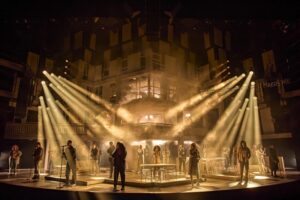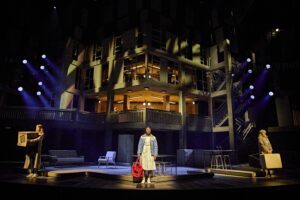Sheffield high-rise musical hits the heights
★★★★

With a book written by Chris Bush and music by Richard Hawley, both born in Sheffield, and direction by Robert Hastie, who is the Artistic Director of the city’s Crucible theatre where it began life, Standing At The Sky’s Edge is Made In Sheffield, just as much as the steel for which the city was famous. Yet it has a universal appeal, as shown by its the National Theatre and now to the West End.
Starting in 1961 and spanning nearly sixty years, the musical tells the story of three families who at separate times live in a high-rise flat in the huge Sheffield housing estate called Park Hill. Their narratives later intersect but initially it seems like a portrait of three discrete times adding up to a history of modern Britain. There’s the socialist optimism following the second world war; the decimation of industrial Britain and the destruction of working-class communities during the Thatcher years (Act One concludes with a shocking riot to the tune of There’s A Storm A-Coming); and today’s liberal-minded but materialistic services economy. I assume Chris Bush leans to the left but she wears her socialism lightly.
They all have their histories, their tragedies, and most of all their love stories. A neon sign says ‘I love you Will u marry me’ replicating the real sign on the flats which itself was based on a famous piece of graffiti.
The main interest is in characters who try to make the best of their situations, even if some fall through the cracks. Her dialogue flows as smoothly as the River Sheaf.
The musical begins with a traditional British working-class couple moving in, thrilled to have all mod cons. Rachael Wooding as Rose is excellent as she goes from excited young wife to strong partner when her husband loses his job following the steelworks closures and to a weary acceptance when life often doesn’t work out as expected, exemplified in her heart breaking rendition of After The Rain. Her husband Harry, played by Joel Harper-Jackson, makes a journey too, starting as a confident provider, then falling apart as so many proud working-class men did without a job to give meaning to their lives.
Next, as the estate becomes run down, we see the arrival of immigrant refugees. Joy has been brought by her aunt and uncle from Liberia to the safety of Sheffield. Played by Elizabeth Ayodele, she undergoes a transformation as she rebels against the values of the old country and adopts the culture of Sheffield, including a change in accent.
Finally, we meet Poppy, perhaps the one with whom we will feel the most in common. She’s a marketing person from London who has headed north to get over a broken relationship. Although she has the least dramatic story, mainly relying on jokes about today’s middle class lifestyle, it’s hard not to be touched by Laura Pitt-Pulford as she conveys Poppy’s desire to be part of a community. Lauryn Redding as her desperate ex belts out a rousing version of Open Up Your Door.

Chris Bush’s witty, angry and moving script finds parallels in the different eras, so that all three families eventually appear on the stage at the same time, their conversations overlapping. It’s a real sense of how a building retains its history and a way to see how much ostensibly different people can have in common. It reminded me of some of Alan Aykbourn’s experiments in presenting more than one narrative simultaneously on stage. The disadvantage of this approach is that it’s harder to become involved with individual stories.
The selection of Richard Hawley’s poetic songs creates an impressive soundtrack for a rock musical but there is plenty of variation in style. A blistering bluesy version of the title number opens Act Two. The many excellent songs, angry, poignant or passionate, augment what’s happening on stage and are wonderfully performed but inevitably they seem too often as if they have been tacked on to the story rather than integral to it, like the blistering bluesy version of the title number that opens Act Two.
Robert Hastie moves these various narratives deftly around the set and at tiumes has the whoile cast of over thirty players interweaving on stage. Lynn Page’s clever choreography at times had the cast moving in a rhythmical walking motion and swaying embraces, uniting different times, generations and classes.
Ben Stone’s set is magnificent, filling the stage with a three storey section of a building with the features of a Park Hill high rise. The main action takes place on a basic but sufficient representation of a flat while the upper two floors are occupied by a large band. The flat apparently offers a glorious view of Sheffield but for us it is down-to-earth.
Standing at the Sky’s Edge is an excellent musical that not only has much to say but says it from the heart. It deserves a long life in the West End.
Click here to buy tickets directly.
Paul was given a review ticket by the producer.